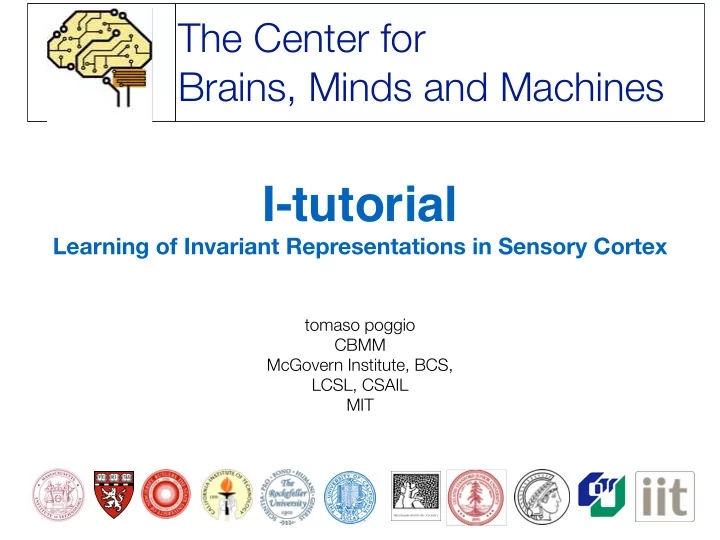

The Center for Brains, Minds and Machines I-tutorial Learning of Invariant Representations in Sensory Cortex tomaso poggio CBMM McGovern Institute, BCS, LCSL, CSAIL MIT
I-theory Learning of Invariant Representations in Sensory Cortex 1.Intro and background 2.Mathematics of invariance 3.Biophysical mechanisms for tuning and pooling 4.Retina and V1: eccentricity dependent RFs; V2 and V4: pooling, crowding and clutter 5.IT: Class-specific approximate invariance and remarks 2
Class 23 Wed Nov 26 Learning Invariant Representations: 3. Biophysical mechanisms for tuning and pooling 3
Summary of previous class 4
M-Theory So far: compact groups in M-theory extend proves invariance+uniqueness theorems for • partially observable groups • non-group transformations • hierarchies of magic HW modules (multilayer)
End Summary 6
Biophysical mechanisms for tuning and pooling - A single cell model of simple and complex cells (any fixed nonlinearity is OK) - Hebb synapses, PCAs and Gabor - PCAs, Foldiak and pooling - Mirror-symmetric tuning in the face patches
Our basic machine: a HW module (dot products and histograms for an image in a receptive field window) • The cumulative histogram (empirical cdf) can be be computed as ... • This maps directly into a set of simple cells with threshold • …and a complex cell indexed by n and k summating the simple cells
Dendrites of a complex cells as simple cells … Active properties in the dendrites of the complex cell
Biophysical mechanisms for tuning and pooling - A single cell model of simple and complex cells (any fixed nonlinearity is OK) - Hebb synapses, PCAs and Gabor - Pooling - Mirror-symmetric tuning in the face patches
Linking ¡Conjecture
Unsupervised ¡tuning ¡(during ¡development) ¡ and ¡eigenvectors ¡of ¡covariance ¡matrix Hebb synapses imply that the tuning of the neuron converges to the top eigenvector of the covariance matrix of the “frames” of the movie of objects transforming. The convergence follows the Oja flow Different cells are exposed (during development) to translations in different directions.
Gaussian ¡aperture: ¡the ¡cortical ¡equation
The ¡cortical ¡equation: ¡general ¡properties
Cortical ¡equation ¡in ¡2D: ¡ natural ¡images, ¡Gabor-‑like ¡receptive ¡fields Carandini Rust et al. 2005
2D ¡eigenvectors In 1D the eigenvectors are Gabor like functions. In 2D the solutions are also Gabor with an orientation orthogonal to the direction of motion. Motion, together with high-pass filtering in the retina induces symmetry breaking that allows non-symmetric solution to emerge. Note that for motion at constant speed
Gaussian ¡aperture: ¡the ¡cortical ¡equation
Prediction ¡agrees ¡with ¡data!
Cortical ¡equation ¡in ¡2D: ¡ natural ¡images, ¡Gabor-‑like ¡receptive ¡fields Carandini Rust et al. 2005
Cortical ¡equation ¡in ¡2D: ¡ natural ¡images, ¡Gabor-‑like ¡receptive ¡fields
Cortical ¡equation ¡in ¡2D: ¡ natural ¡images, ¡Gabor-‑like ¡receptive ¡fields
Natural ¡images, ¡Gabor-‑like ¡receptive ¡fields
Natural ¡images, ¡Gabor-‑like ¡receptive ¡fields
Natural ¡images, ¡Gabor-‑like ¡receptive ¡fields
Prediction ¡agrees ¡with ¡data ¡(not ¡fully)
Beyond ¡V1: ¡work ¡in ¡progress
Beyond ¡V1, ¡towards ¡V2 ¡and ¡V4
Beyond ¡V1, ¡towards ¡V2 ¡and ¡V4: ¡ wavelets ¡of ¡wavelets
We ¡are ¡working ¡on ¡implementing ¡ the ¡full ¡theory ¡ (the ¡corresponding ¡model ¡contains ¡ Hmax ¡and ¡convolutional ¡networks ¡ as ¡special, ¡simple ¡cases)
Cortical ¡equation ¡in ¡2D: ¡ natural ¡images, ¡Gabor-‑like ¡receptive ¡fields Carandini Rust et al. 2005
Prediction ¡agrees ¡with ¡data ¡(not ¡fully)
V2 ¡and ¡V4: ¡ wavelets ¡of ¡wavelets Responses of two model complex cells pooling 3D wavelets (top) and two real V4 cells (bottom) to various stimuli used by Gallant. Red/orange indicates a high response and blue/green indicates a low response.
Face patches in IT
Face ¡patches
Magic algorithm “works”
Linking ¡Conjecture • Predicts Gabor-like tuning of simple cells in V1 • Qualitatively predicts tuning in V2/V4 • Predicts/justifies mirror-symmetric tuning of cells in face patch AL
Magic ¡architecture ¡for ¡pose-‑invariant ¡face ¡identification Viewpoint ¡tolerant ¡units ¡ (complex ¡units) View-‑tuned ¡units, ¡tuned ¡to ¡full-‑face ¡ templates ¡for ¡different ¡view ¡angles Joel+Jim+tp, 2010
If Hebbian learning holds also for the face patches, then the theory predicts that between the view tuned patches and the view-invariant patch there should be mirror symmetric cells. Lemma: PCAs for faces are odd or even functions, and so energy models complex cells are always even
Response of simple AL “model” cells to different views of a face of brain theory
Remarks 47
The ¡ventral ¡stream: ¡ an ¡architecture ¡that ¡learns ¡and ¡discount ¡transformations ¡ an ¡architecture ¡determined ¡by ¡invariances ¡of ¡the ¡physical ¡world • ¡The ¡goal ¡of ¡the ¡cortical ¡hierarchy ¡is ¡learning ¡and ¡factoring ¡out ¡transformations ¡( learning ¡from ¡ data ¡“any” ¡invariance ) • ¡Features ¡and ¡statistics ¡of ¡natural ¡images ¡do ¡not ¡matter, ¡transformations ¡do, ¡are ¡learnable ¡from ¡ random ¡noise ¡images • Most ¡important ¡ ¡are ¡complex ¡cells ¡and ¡their ¡pooling ¡domain: ¡this ¡represents ¡symmetries/ invariances ¡learned ¡from ¡the ¡world ¡-‑-‑ ¡eg ¡equivalence ¡classes ¡of ¡templates • Invariances ¡are ¡learned ¡by ¡memory-‑based ¡computation, ¡just ¡recording • ¡Aperture ¡size ¡determines ¡which ¡transformation, ¡transformation ¡determines ¡tuning ¡in ¡V1 ¡V2 ¡V4 • Architecture ¡predicts ¡stability ¡of ¡visual ¡perception ¡wrt ¡small ¡eye ¡motions • Class-‑specific ¡transformations ¡predict ¡class-‑specific ¡modules
¡ ¡Top ¡module Associative memory
Recommend
More recommend